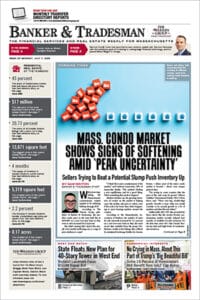While waterfront developers produce display boards and heavy tomes describing impacts and regulatory agencies and other reviewers walk the tightrope between economic development and environmental protection, we are missing an opportunity. In heated discussions about development-related traffic, stakeholders overlook the potential of water transportation. With the right public policy, water transportation could create real estate value, reduce traffic volume and provide useful neighborhood connections.
The Executive Office of Environmental Affairs and its Department of Environmental Protection engaged a consultant to develop strategies for increasing water transportation through the Chapter 91 licensing process. Without a new mindset, this endeavor will fail. Under the old model, state transportation agencies subsidized Boston’s Inner Harbor water shuttle service to encourage motorists to seek alternate transportation modes during highway construction. The agencies turned to the Massachusetts Bay Transportation Authority to procure the shuttle service. The MBTA contracted with a private operator, using subsidies to cover the gap between service cost and fare box receipts.
Those subsidies from highway construction mitigation will end soon. The state has required the World Trade Center to assume some of that subsidy, but only temporarily. Without subsidies, fare increases and service cutbacks are inevitable. This will reduce ridership and aggravate road congestion and air-quality problems.
We need a new model for Boston Harbor water transportation, without complex subsidy calculations and a bureaucracy to administer them. Instead we must motivate developers to provide cross-harbor connections at low fares. Only then will commuters, tourists and residents use water shuttles without hesitation.
The new model requires collaboration among waterfront developers, tourism interests, the Boston Redevelopment Authority and Boston Transportation Department, entrepreneurial passenger vessel operators and all regulatory agencies reviewing development proposals. The model requires regulators, riders and real estate interests to look beyond the MBTA, the standard provider of mass transit.
The model requires the city and other regulatory agencies to press developers on Transportation, Demand Management (TDM) strategies and to challenge parking ratios proposed by developers. After all, developers currently build structured parking and realize rapid return with unit sales. The new model requires public policy to restrict on-site parking along the waterfront. Developers will only take water transportation seriously if unit sales and commercial leases depend on the availability of convenient, low-priced cross-harbor connections.
Developers of property abutting the blue highway can truly benefit from a well-designed water shuttle service since their retail tenants will have captive markets in the form of foot traffic going through sites to reach the dock every day. Their office tenants will have a work force arriving ready to work, no longer stressed by highway commuting. Their hoteliers can market scenic connections from Logan Airport as the Boston Harbor Hotel has successfully demonstrated. Their condo buyers can dispense with the second vehicle. The right water transportation is not a premium cost, but rather a signature asset. Therefore, the new model requires developers to provide well-located docks to facilitate passenger boarding and to minimize vessel tie-up/turn-around time. Developers should offer lease periods that facilitate vessel financing at rates competitive with other harbor locations.
The new model requires operators to offer a high level of service from the start with vessels designed specifically for the route, trip frequencies appealing to commuters and discretionary riders and dependable service geared to passenger comfort, convenience and safety. This will capture ridership. The new model requires incentives for vessel operators just as for developers. Developers need the shuttle service to work on day one in order to attract tenants. Therefore they must help the operator at the outset when passenger volume cannot support the trip cost. Such supplements should be phased out, however, so as to motivate the vessel operator to maintain excellent service while being entrepreneurial in seeking new markets. This will increase ridership, effectively lowering the cost per rider.
The new model requires public policy changes so that parking requirements mandated in zoning regulations actively support smart growth and mass transit initiatives. City agencies must also be consistent in the treatment of waterfront parking. Finally, city and other regulatory agencies should expedite the review process for development projects with TDM strategies featuring specific arrangements with proven vessel operators.
Essence of Motivation
The model requires regional transportation agencies to recognize the contribution of private vessel operators to public initiatives designed to reduce vehicle miles traveled and promote clean air. These agencies should include all passenger water transportation services in their print and other media publications. They should coordinate special promotional fares with private ferry operators, with enough lead time to ensure operational efficiencies. They should explore free transfers for commuters riding private ferry service. They should actively engage vessel operators and developers in efforts to link T stations and tourist destinations with docking facilities.
Motivation is the essence of the new water transportation model for Boston. Regulatory agencies must instill that motivation in developers so that the blue highway is more than a visual asset. Improved access afforded by that blue highway will add unique value to adjacent real estate. Developers can motivate vessel operators to be entrepreneurial in promoting ridership through a schedule of decreasing financial assistance and enforcement of performance criteria.
Early cooperation among regulators, real estate interests and vessel operators will enable Boston Harbor to be more than a pretty picture, a recreational resource and a working port. We must take advantage of the Harbor’s capacity to move residents, commuters and tourists between waterfront destinations and bestow economic benefit to the region.






